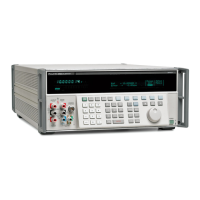5700A/5720A Series II
Operators Manual
6-16
Table 6-2. Annotation for Shift Results Printout
A
The date and time that the calibrator printed the report. (This is not the date and time of calibration.)
B
The user report string contents. (Set by the remote RPT_STR command.)
C
The type of calibration report: Output Calibration or Calibration Check.
• An Output Calibration Report, which can be requested at any time, shows offset and gain
adjustments performed at the last calibration. The report is derived from two sets of calibration
constants stored in non-volatile memory: the active set, and the set that was previously active.
This calibration report is always based on external standards.
• A Calibration Check Report shows recommended calibration adjustments that will never be
stored. The report can be one of two forms, depending on when it’s requested:
The first form of this report is generated if you request the report immediately after calibration,
before any adjustments have been stored. This lets you determine whether to implement the
recommended adjustments. If only minor adjustments are recommended, you may decide to
simply file the report and leave the rear panel Calibration Switch in its Normal position. This
report includes calibration drift information on the calibrator’s internal check standards, based
on the applicable external artifacts standards.
The second form of this report can be requested at any time other than immediately after
calibration. This type of report shows calibrator drift relative to internal check standards, based on
data from a just-completed calibration check. This report is based on externally calibrated internal
check standards rather than actual data; a fact that is stated in the report.
All calibration check data remains in memory and is available for reporting until replaced by a later
calibration check or calibration, or until the calibrator is reset (or the power is cycled).
D
The three characters that follow “Software Revision” provide the firmware versions for the Main
CPU, the Inguard CPU, and the Boost CPU. Each version is separated by a plus (+). If no amplifier
is attached then its position (third character) contains an asterisk (*).
E
A list of each analog module installed in the calibrator and the external amplifiers attached to the
instrument and powered on.-
F
The date and reported temperature of the most recent calibration. This always refers to the
calibration that established the set of cal constants presently in use (stored in EEPROM).
Note
A calibration check reports contain a line that shows the date and temperature of
the calibration check, which refers to the calibration that established the set of
constants presently in temporary memory. This line is indicated by (CalCheck)
and can also refer to constants established by performing output calibration but
not yet saved into EEPROM.
G
The date and temperature of the previous calibration, prior to the most recent one.
H
The number of days between the day the calibration report was printed (#2 above) and the day that
the presently active set of cal constants was stored into EEPROM (#5 above).
I
These numbers are the entered values of the external reference. They will only appear on
calibration reports done on instruments with rev E or higher software. Otherwise, they will be blank
lines.
J
The Resistance Reference is the average of the actual-to-nominal ratios of the 100Ω, 190 Ω, 1 k Ω,
1.9 k Ω, 10 k Ω, 19 k Ω, 100 k Ω, and 190 k Ω resistors. Prior to revision H, this line showed the
calibrated value of the internal 10 k Ω reference resistor. As of revision H, the line is changed as
shown in the report.

